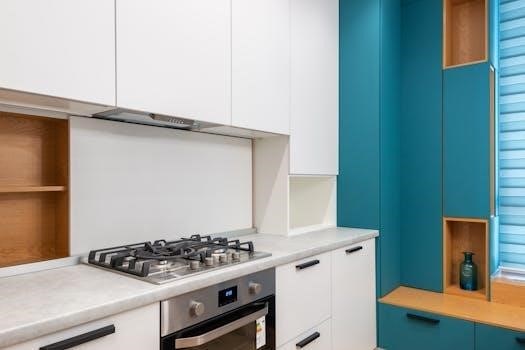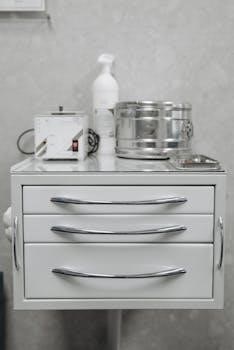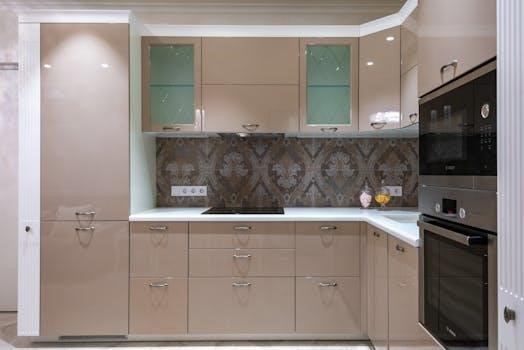Upgrading your cabinets with new handles is a simple yet impactful way to refresh your space. This guide provides a comprehensive overview of the process‚ from selecting the right handles to ensuring a professional installation. This will help elevate the aesthetics and functionality of your kitchen or bathroom.
Importance of Cabinet Handles
Cabinet handles are more than just decorative elements; they are crucial for functionality and can significantly impact the overall look and feel of a room. They provide a comfortable grip‚ making it easier to open and close drawers and doors‚ contributing to the ease of daily use. Choosing the right handles can dramatically elevate the aesthetic‚ adding a touch of sophistication and style. Furthermore‚ they can update an old space and make it more modern by adding new handles‚ making them a vital component in both design and practicality.

Types of Cabinet Handles
Cabinet hardware comes in various styles‚ including knobs and pulls. Knobs are small and round‚ ideal for subtle touches. Pulls offer a larger grip‚ creating a bolder statement. Choosing the right type depends on the style you want.
Knobs vs Pulls
Knobs‚ typically smaller and round‚ are often chosen for drawer fronts and small cabinet doors‚ offering a subtle‚ classic look. They are easy to install with a single screw‚ making them a popular and straightforward choice. Pulls‚ conversely‚ provide a larger gripping area and tend to create a bolder visual statement‚ making them ideal for larger drawers and cabinet doors. Consider the functionality you desire‚ as pulls offer an easier and more comfortable grip compared to knobs; Ultimately‚ the choice between knobs and pulls depends on your personal style and the desired aesthetic of your space.
Essential Tools for Installation
Before starting‚ gather essential tools like a tape measure‚ pencil‚ drill‚ screwdriver‚ and level. These tools ensure accurate handle placement and a professional finish. Having the right tools is vital for success.
Required Tools and Materials
For a successful cabinet handle installation‚ you’ll need a few key tools and materials. A tape measure is crucial for precise measurements‚ and a pencil will mark your desired locations. You’ll also require a drill with the appropriate size bit for pilot holes. A screwdriver is essential for fastening the handles‚ and a level will ensure straight alignment. Consider a template for consistent placement. Having these items ready before you begin will streamline the process and ensure a secure and professional-looking result. A drill bit matching the screw size of the hardware is also crucial.
Handle Placement Guidelines
Proper handle placement is key for both functionality and aesthetics; Consider horizontal placement for drawers and vertical for doors. Consistency between upper and lower cabinets is also crucial for visual balance.
Horizontal and Vertical Placement
When deciding on handle orientation‚ consider the function of the cabinet. For drawers‚ horizontal placement is generally preferred‚ allowing for a natural pulling motion. On doors‚ vertical handles are more common‚ facilitating an easy swing open. However‚ for some taller cabinet doors‚ a horizontal placement in the middle can also be considered. Ultimately‚ choose the orientation that feels most intuitive and comfortable for your needs‚ while also complementing your design style. Remember to maintain consistency throughout your space for a cohesive look‚ using the same orientation in similar areas.
Placement on Upper and Lower Cabinets
Placement of handles on upper and lower cabinets often differs for both functionality and visual harmony. Upper cabinet handles are typically installed 1 to 4 inches from the bottom of the door‚ making them easily accessible. Conversely‚ lower cabinet handles are usually placed 1 to 4 inches from the top of the door. Matching the placement on both upper and lower cabinets creates visual symmetry. Some prefer hardware in the middle of taller cabinets‚ but consistency is key for a balanced aesthetic. It’s crucial to consider both access and overall design.

Installation Steps
The installation process involves precise measuring and marking‚ followed by drilling pilot holes to guide the screws. Securing the handles carefully will complete the process. This ensures a secure and professional finish.
Measuring and Marking
Begin by accurately measuring the desired location for your cabinet handles using a tape measure. For a balanced look‚ center the handle horizontally on drawers and consider a vertical position for cabinet doors. Mark the screw hole locations with a pencil‚ ensuring precise alignment. Double-check these measurements before proceeding. For handles with two screws‚ mark the center of the handle’s intended position. Accurate measurements are crucial for a professional-looking installation‚ so take your time and ensure everything is correctly marked. This will help to avoid mistakes later in the process.
Drilling Pilot Holes
Once you’ve marked the handle positions‚ it’s time to drill pilot holes. Select a drill bit that matches the screw size of your hardware; often‚ a 3/16-inch bit works well. Refer to your handle’s instructions for specific recommendations. Hold the cabinet door or drawer securely while drilling to prevent movement. Drill straight through at your marked points to create clean‚ even pilot holes. These pilot holes are crucial to prevent the wood from splitting and make the screw installation easier and more accurate. Ensure the holes are deep enough for the screws to securely fasten the handle.

Using a Template
Using a template is highly recommended‚ especially when installing multiple handles. Templates ensure consistent placement‚ reduce errors‚ and speed up the installation process. They are available in stores and online.
Benefits of Using a Template
Employing a template for cabinet handle installation offers numerous advantages. Firstly‚ it ensures uniform and precise placement of handles across all cabinets‚ creating a cohesive and professional look. Secondly‚ it significantly reduces the chances of errors and misalignments‚ preventing the need for redrilling or rework. A template also streamlines the installation process‚ making it faster and more efficient. Furthermore‚ it simplifies the task‚ even for those without extensive DIY experience. By using a template‚ you save time and effort while achieving a consistently high-quality result. Templates will increase your accuracy.
Common Mistakes to Avoid
Avoid clashing styles by carefully selecting handles that complement your cabinets. Inaccurate measurements can lead to misaligned hardware. Always double-check your measurements before drilling and ensure the hardware matches your style.
Clashing Styles and Inaccurate Measurements
One common mistake is choosing cabinet hardware that doesn’t match the overall style of your kitchen or bathroom. Mixing modern pulls with traditional cabinetry‚ for example‚ can create a visually jarring effect. Another frequent error is inaccurate measurements‚ which can lead to unevenly placed handles. This not only looks unprofessional but can also affect the functionality of your cabinets. Always double-check your measurements‚ and use a level to ensure perfect alignment. It is also important to consider the size and proportion of the handles to maintain a balanced look.

Final Thoughts
Proper handle installation is a simple yet effective way to enhance the overall look and feel of your space. By paying attention to detail‚ you can achieve a professional finish.
Impact of Handle Installation on Room Aesthetics
The selection and installation of cabinet handles can significantly impact the visual appeal of a room. These small details contribute to the overall design‚ reflecting your personal style. Sleek‚ modern pulls can elevate a contemporary kitchen‚ while classic knobs add charm to a traditional space. The right hardware enhances not only the functionality but also the aesthetic harmony of the entire room. Choosing the perfect handles is about balancing form and function‚ ensuring the hardware complements the cabinets and the overall decor. It is important to consider how the handles will integrate with the surrounding design elements.
